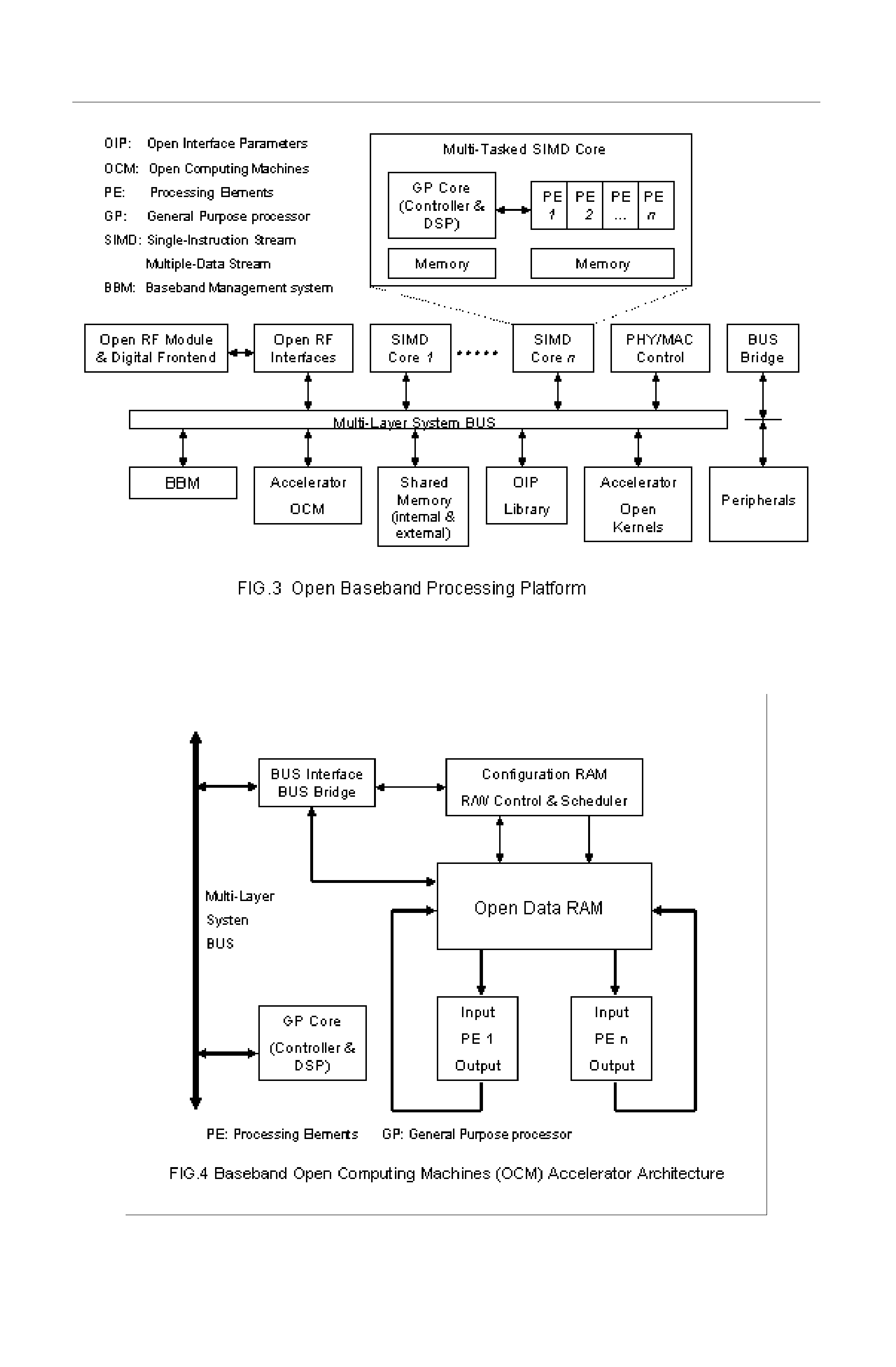[0021]This invention is directed to an open baseband processing architecture for next generation wireless and mobile communication terminal design which provides an optimal open baseband processing platform supporting different existing and future defined wireless radio transmission technologies (or air interfaces) including, but not limited to, W-CDMA (code division multiple access), cdma2000, GSM, GPRS, OFDMA (orthogonal frequency division multiple access), WLAN (wireless local area network), WPAN (wireless personal access network) and BWA (broadband wireless access system), either in the simultaneous connection mode, or in the selective connection mode of various wireless standards in the user's service geographic region, where different radio standards are mapped into the open interface parameters as inputs to the open processing modules scheduled and administrated by the Baseband Management system for the optimization of the system performance and resource of the wireless mobile terminal.
[0022]The open baseband processing architecture of the present invention incorporates a multi-dimensional open processing architecture including the general-purpose processors and digital signal processors (DSP) to handle the main flow of the baseband algorithms and protocols, and the special processing accelerators to focus on the computationally intensive repetitive operations of specific communication-oriented algorithms, such as, but not limited to, space-time transceiver processing, adaptive modulation, channel coding and equalization. The processing accelerators of the present invention are very important open processing subsystems in the mobile terminal design because they utilize the distributed open modular flexible architecture to achieve the ASIC-like efficiency and performance. The processing accelerators of the present invention include two different open accelerators: OCM (Open Computing Machines) Accelerator and Open-Kernels Accelerator. The OCM Accelerator of the present invention is a very efficient and powerful processing engine for complex repetitive communication-oriented algorithms, including, but not limited to, adaptive modulation and space-time processing. The Open-Kernels Accelerator of the present invention handles independent or dependent communication protocol cores, algorithm cores, and service and application processing cores, including, but not limited to, open service architecture processing and service convergence processing. The multi-dimensional open processing architecture of the present invention also includes the multi-tasked SIMD (single-instruction stream, multiple-data stream) processing cores to deal with the small scale wireless convergence and integration solution, for example, but not limited to, W-CDMA / GSM / WLAN 3-in-1 integrated terminal, and CDMA / OFDM 2-in-1 integrated terminal. In this case, the aforementioned SIMD Cores can handle all the communication algorithms and protocols, and the aforementioned accelerators can be turned off in order to save terminal power and minimize the power consumption.
[0023]The open baseband processing architecture of the present invention incorporates an efficient baseband management method based on the open processing tree. The open processing tree of the present invention includes, but can be reconfigured, a) processing root utilized by the system main processor, handling general system operations and maintenances; b) processing trunk utilized by aforementioned general-purpose processors and DSPs or aforementioned SIMD cores, handling the main flow of the baseband algorithms and protocols, and controlling the accelerators; c) processing branches utilized by aforementioned OCM Accelerators and aforementioned Open Kernels Accelerators, handling the complex communication-oriented algorithms and protocols; d) processing leafs utilized by aforementioned Open Kernels Accelerators or the general-purpose processors and DSPs of the aforementioned SIMD Cores, handling general processing of Open Services Architecture (OSA). The open tree architecture of the present invention is a proven efficient tasks scheduler for open baseband processing of the future mobile terminal, where users can reconfigure the processing tree to optimize the system performance. If the aforementioned tree is small enough, for example of simple wireless convergence of 2-in-1 or 3-in-1 integrated terminal, the aforementioned SIMD cores are capable of handling all the baseband processing tasks of the system, and therefore the system power consumption can minimized.
[0026]The open baseband processing architecture of the present invention guarantees that all the processing modules are open modules instead of standard-specific modules which are used by the existing mobile communications. These open modules based on Open Wireless Architecture (OWA) with Open Interface Parameters (OIP) are the shared processing engines for the different wireless standards to maximize the system processing efficiency. Meanwhile, many of the aforementioned open modules are the independent modules which can be easily turned off / on based on the system requirement and resource management to minimize the terminal power consumption. The open interface parameters of the present invention map between the various wireless standards and the open processing modules, and incorporate capabilities to define new radio transmission technology for the future wireless mobile communications.
 Login to View More
Login to View More  Login to View More
Login to View More 


